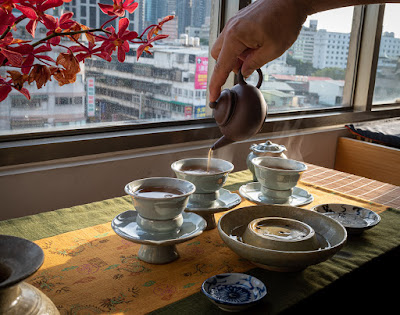Pour Soetsu Yanagi, l'ami du potier Bernard Leach (1887-1979), un critère important de la beauté d'un objet est son utilité. La beauté ne saurait pas simplement être esthétique, mais elle se doit aussi d'être pratique. Avant d'apprécier ses formes, ses couleurs, on apprécie surtout l'aide que cet objet nous apporte, la manière dont il remplit sa fonction avec brio. Soetsu Yanagi développe cette reflexion dans 'the unknown craftsman, a Japanese insight into beauty'.
Dans ce livre, il est beaucoup question de thé, car c'est l'activité Japonaise par excellence qui fait appel à des objets artisanaux à la fois pour leur beauté et leur utilité. En effet, la raison d'être du thé, c'est d'être dégusté, pas d'être collectionné comme une oeuvre d'art!
Il y a quelque chose de très moderne et d'écolo dans cette pensée: au lieu de créer des objets d'art beaux mais inutiles, les artistes devraient surtout créer des objets utiles et beaux! Ainsi, notre vie se trouverait à la fois embellie et facilitée!
Dans cet esprit, un accessoire qui reste toujours dans le placard ou sur son étagère, c'est un objet qui n'existe pas car il ne nous rend jamais service. Pareillement, un thé qu'on garde indéfiniment dans une jarre ou un sachet, c'est un thé qui n'existe pas pour nous! La beauté d'un accessoire ou d'un thé est affaire d'expérience, de sensations et de souvenirs.
Et c'est cela qui est sympa avec un Oolong torréfié traditionnel: on peut le déguster sur de nombreuses années et suivre son évolution. Le thé devient un compagnon vivant avec lequel on va jouer pour obtenir des arômes raffinés! Ici, j'ai préparé une Beauté Orientale de Hsin Chu d'automne 2010. Cet Oolong commence à développer des senteurs un peu boisées et âgées en plus de ses notes fruitées et mielleuses.
J'ai récemment appris que les Oolongs Beautés Orientales sont souvent au menu des diners d'inauguration des présidents de la République de Chine (= Taiwan). Ces diners officiels sont l'occasion pour le président entrant de montrer son attachement au terroir de Formose en utilisant les produits locaux. Or, si l'on choisit plutôt la Beauté Orientale qu'un Dong Ding ou un Gao Shan, c'est surtout car ce thé fortement oxydé a des arômes généreux, et qu'avec sa torréfaction, il a une bonne longueur en bouche. Le tout permet de réaliser de jolis mariages entre mets et thé.
Pouvoir utiliser un thé lors d'un Chaxi et lors des repas ajoute à son utilité, et donc, comme dirait Yanagi, à sa beauté! Et si en plus on le prépare un tant soit peu avec de bons accessoires et des couleurs harmonieuses, c'est le bonheur! Un gaiwan facile à manipuler est alors un excellent exemple de beauté fonctionnelle.
Juin est la saison phare pour la récolte des Beautés Orientales. Mais leur production va se prolonger tout l'été, car elle requiert une torréfaction attentive pour les parachever et bien les affiner. Il n'est pas nécessaire de se précipiter sur les nouvelles feuilles quand celles de 2010 sont si bonnes! La vraie beauté est pérenne. Elle ne connait pas les modes.
La beauté du thé dépasse sa dimension esthétique. La reflexion de Soetsu Yanagi nous entraine à des niveaux bien plus profonds et pour chaque objet du Chaxi on peut à la fois se poser la question de sa beauté, de son utilité et de sa relation avec les autres accessoires. Le tout est-il harmonieux? A-t-on fait honneur au thé et à la vie? La beauté de cet instant ne nous est-elle pas aussi utile pour nous donner envie de vivre?
2024 vs 2023 Tea Encounter YiShanMo Gushus!
2 hours ago











































